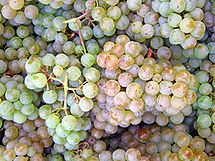- Pinot blanc
-
Pinot blanc Grape (Vitis) 
Pinot blanc grapes Color of berry skin Blanc Species Vitis vinifera Also called Weissburgunder or Klevner (Austria), Fehér Burgundi (Hungary), Pinot bianco (Spain and Italy), Rulandské bílé (Czech), Rulandské biele (Slovak) Notable regions (see major regions) Pinot blanc is a white wine grape. It is a point genetic mutation of Pinot noir. Pinot noir is genetically unstable and will occasionally experience a point mutation in which a vine bears all black fruit except for one cane which produced white fruit.
Contents
Origins and regional production
In Alsace, Germany, Luxembourg, Italy, Hungary, Czech Republic and Slovakia, the wine produced from this grape is a full-bodied white. In 2000, there were 1,300 hectares (3,200 acres) of Pinot blanc in France,[1] with most of the plantations found in Alsace, where it is used for both still white wines and is the most common variety used for sparkling wine, Crémant d'Alsace. Somewhat confusingly, the designation "Pinot blanc" for Alsace AOC wine does not necessarily mean that the wine is varietally pure Pinot blanc. (This is in difference to Pinot gris, which is a "true" varietal designation in Alsace.) Rather, the designation means that it is a white wine made from Pinot varieties. Under Alsace appellation rules, the varieties Pinot blanc, Auxerrois blanc, Pinot gris and Pinot noir (vinified white, without skin contact) may all be used,[2] but a blend of Pinot blanc and Auxerrois is the most common. The most full-bodied "Pinot blanc" wines from Alsace, with a spicy and smokey character and moderate acidity, are likely dominated by Auxerrois grapes.
Historically, Pinot blanc was used both in Burgundy and Champagne.[1] It is still allowed in the Champagne blend and small amounts of Pinot blanc may in principle be blended into some Burgundy wines, but very small amounts are cultivated in either region. In the Champagne region, Pinot blanc is often called Blanc vrai.
In Germany, where it is known as Weißer Burgunder or Weißburgunder, there were 3,491 hectares (8,630 acres) of Pinot blanc in 2006.[3] The most powerful versions are usually made in Baden and Palatinate. In the United States it is mainly produced in California. In the United States, many of the vines called Pinot blanc are actually a different variety, Melon de Bourgogne/Muscadet, that resembles Chardonnay when on the vine. This mistake was discovered around the mid 1980s by a French oenologist who was examining rootstock while visiting University of California, Davis, and now Pinot blanc purchased from a nursery will be the genuine article. The grape is also grown in Austria and Hungary as well as in Burgundy, France.[4]
Pinot blanc has also been confused with Chardonnay, and wineries often vinify it in a similar style, using barrel fermentation, new oak and malolactic fermentation. It can also be treated more lightly and made into a crisper wine that still has some ability to age.
Wine characteristics
In Alsace, Italy and Hungary, the wine produced from this grape is a full-bodied dry white wine while in Germany and Austria they can be either dry or sweet.[4] One of the components of the wine Vin Santo can be Pinot blanc.[4]
In France the grape is often blended with Klevner, sometimes referred to by locals as "true Pinot," and Auxerrois grapes, in order to give it a more alsacian flavor.[5]
Bottles labeled Pinot Blanc offer fruity aromas, often of apple, citrus fruit, and floral characteristics. Bottles that are varietally pure, although more difficult to find, provide stronger floral characteristics, stone fruits and a headier minerality. Robert Parker suggests Boxler's Reserve Pinot Blanc as one such "true Pinot" wine. Regardless of their exact composition, most wines under the label 'Pinot Blanc' are rather high in acidity and are vinified in tank, though more prestigious examples are fermented in large, 100% used oak barrels. Pinot blanc wines are usually made for immediate consumption and seldom meant for cellaring.
Names in other regions
Pinot blanc's name varies by region. In Austria it may be bottled as Weissburgunder or Klevner (also occasionally named so in Alsace). Hungary calls it Fehér Burgundi. Spain and Italy refer to it as Pinot bianco. In the Czech Republic, it is known as Rulandské Bilé. In Slovakia it is called Rulandské Biele. In Serbia it is called Beli burgundac.
See also
References
- ^ a b Jancis Robinson, ed (2006). "Pinot Blanc". Oxford Companion to Wine (Third Edition ed.). Oxford: Oxford University Press. pp. 528–529. ISBN 0-19-860990-6.
- ^ INAO: AOC Alsace appellation regulations, updated until February 16, 2006
- ^ German Wine Institute: German Wine Statistics 2007-2008
- ^ a b c L. Brenner, Fear of Wine, p. 69 (1995) ISBN 0553374648
- ^ Pinot blanc Wine Information, French Wine Guide in Alsace
Wines General Wine styles Grape varieties International
varietiesWhiteRedRegional
varietiesWine-producing countries (regions) - New South Wales
- South Australia
- Tasmania
- Victoria
- Western Australia
OtherCategories:- White wine grape varieties
Wikimedia Foundation. 2010.
